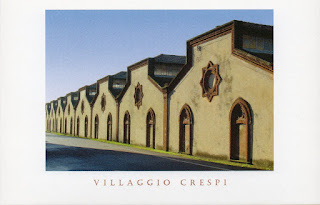Recently my wife and I spent a weekend in Italy and we visited Crespi d'Adda. It was really cool! We rent two bikes and we visited the village in less than an hour. Unfortunately the factory is closed and the castle cannot be visited but it was worth it!
 |
| Aerial view in 1927 |
Crespi is the name of a family of cotton manufacturers from Lombardy. This family realized an "ideal workers' village" nearby their factory, along the Adda river.
The Villaggio Crespi d'Adda (Crespi Workers' Village) is an entire town, built from nothing by the owner of the factory for his workers and their families. The workers were provided with homes, gardens, vegetable gardens and all necessary local services.
In this perfect little world the master of Crespi "reigned" from his castle and, like a caring father, satisfied all needs of his employees: "from the cradle to the grave" both inside and outside the factory, predating any official state benefits or provisions. Only those who worked in the factory could live in the Village, and the life of everybody was connected to the factory, its rhythms and its demands. - in: http://www.villaggiocrespi.it/en/
 |
| Factory |
 |
| Factory |
Cristoforo Crespi introduced the most modern spinning, weaving and finishing processes in his Cotton Mill. The Hydroelectric power plant in Trezzo, on the Adda river just a few Km upwards, was built up around 1906 for the manufacturer Cristoforo Benigno Crespi. - in: wikipedia
 |
| Factory |
The great depression of 1929 and the harsh fascist fiscal policy resulted in the Crespi family being obliged to sell the entire town to STI, the Italian textile enterprise, which transferred it to the Rossarl e Varzi company in 1970. It then passed to the Legler company, which sold off most of the houses. It was last in the hands of the Polli industrial group, which employed some 600 people, as compared with the 3200 employed during the years of maximum activity.
Today the village is inhabited by a community largely descended from the original workers. The factory stopped production only in 2004, its field of activity throughout its working life having been cotton textile production. - in: wikipedia
 |
| Crespis' Castle |
The castle and church were built geographically aligned and facing each other such that if you were to look out from the castle's tower it is possible to see directly into the church door and to the altar
Despite being in the province of Bergamo, Crespi shares the Milan telephone prefix (02). This is a direct consequence of the Crespi family installing a private line between their castle in Crespi and home in Milan at the end of the nineteenth century. - in: http://www.villaggiocrespi.it/en/
 |
| Houses |
The village of Crespi d'Adda was the first village in Italy to have modern public lighting. The workers houses, of English inspiration, are lined up in order along parallel roads to the East of the factory. A tree-lined avenue separates the production zone from the houses, overlooking a chequer-board road plan. The whole architecture and town planning (except the first spinning department, created by engineer Angelo Colla), was submitted to the architect Ernesto Pirovano. For about fifty years Pirovano, helped by the engineer Pietro Brunati, ran the construction of the village. - in: wikipedia



































